- Home
- McBain, Ed
Blood Relatives (87th Precinct) Page 2
Blood Relatives (87th Precinct) Read online
Page 2
CARELLA: Paul?
PATRICIA: Paul Gaddis. He’s the boy who had the party. It was his birthday. His eighteenth birthday.
CARELLA: How old are you, Patricia?
PATRICIA: Fifteen. I’ll be sixteen in December. December twelfth.
CARELLA: And your cousin was how old?
PATRICIA: Seventeen.
CARELLA: All right, go ahead. You were walking from Paul’s house—
PATRICIA: Yes.
KLING: On Harding was this?
PATRICIA: Yes. Where all the stores are. Near Harding and Sixteenth. It was raining very hard when we got to Sixteenth, so we stopped under an awning for a while, until it let up. Then we started walking down Harding again, toward Fourteenth. There’s construction going on around there, these buildings are being knocked down, they’re putting up a housing project. So when we got to Fourteenth, it began raining again, and Muriel and I ran into the hallway of this abandoned building. Just to get out of the rain. Till it let up a little. We were only three or four blocks from where we lived, we figured we’d wait a few minutes and then go home.
KLING: Did your cousin live with you, is that it?
PATRICIA: Yes. She came to live with us when I was thirteen. Her parents got killed in an automobile accident on the turnpike.
CARELLA: Do you have any brothers or sisters, Patricia?
PATRICIA: Yes, I have an older brother.
CARELLA: What’s his name?
PATRICIA: Andrew Lowery.
CARELLA: How old is he?
PATRICIA: Nineteen.
CARELLA: Does he still live at home?
PATRICIA: Yes.
CARELLA: Was he at the party tonight?
PATRICIA: No, he was working.
KLING: What kind of work does he do?
PATRICIA: Well, it’s only part-time. There’s this steak joint on the Stem, they call him when they need help, usually on a Saturday night. I guess if he hadn’t been working, he’d have come to the party with us. And then what happened wouldn’t have happened.
KLING: Do you want to tell us what happened now?
PATRICIA: Yes. We were standing in the hallway there, looking out at the rain. I didn’t think it would ever let up. I kept telling Muriel we should just make a run for it, you know, but she didn’t want to ruin her dress. It was coming down in sheets by then, I guess she was right. Still—
KLING: What time was this?
PATRICIA: It must’ve been close to eleven.
CARELLA: Go on.
PATRICIA: There was nobody on the street, everything was deserted because it was raining so hard. We must’ve stood in the hallway there for at least five minutes without even seeing a car go by. Then—I still don’t know how he got there, he must’ve been in the building all along, maybe, sleeping in one of the empty apartments or something—this man was suddenly there. He just stepped out of the shadows behind us, and he grabbed Muriel by the wrist, and she screamed, or at least she started to scream. But then she saw he had a knife and she shut up even before he told her to shut up. I guess my first reaction was to run, to get away from there. But he was holding the knife on Muriel, and I figured if I did anything like that, he might hurt her just out of spite. So I stood there. I guess you just figure, in a situation like that, that it isn’t going to get worse, it’s just going to work out someway, somebody’ll come to save you.
CARELLA: Did you recognize this man? Was he anyone you knew, or anyone you’d seen before?
PATRICIA: No. He was a perfect stranger.
CARELLA: Can you describe him to us?
PATRICIA: Yes. He was a tall man. About as tall as you, I would say. Six-two, or six-three.
CARELLA: That would make him taller than I am.
PATRICIA: Well, no, he was about your height. A little huskier, though.
CARELLA: Was he white or black?
PATRICIA: White.
CARELLA: Did you notice what color his hair was?
PATRICIA: Dark. Either brown or black, but very dark.
KLING: And his eyes?
PATRICIA: He had blue eyes.
KLING: Was he clean-shaven, or did he have a mustache or beard?
PATRICIA: Clean-shaven.
CARELLA: What was he wearing?
PATRICIA: A suit, I think. Or else slacks and a sports jacket, I’m not sure. If it was a sports jacket, it was a solid color. And dark.
CARELLA: Shirt and tie?
PATRICIA: No tie.
CARELLA: Would you recognize him if you saw him again?
PATRICIA: Yes. There wasn’t any light in the hallway, but there was light from the streetlamp. I’d recognize him. And I’d also recognize his voice.
KLING: You said he told your cousin to shut up—
PATRICIA: Yes, that was after she’d stopped screaming already. She screamed when he first came out of the darkness, and then she saw the knife and stopped screaming, but he told her to shut up, anyway.
KLING: What else did he say?
PATRICIA: That he wouldn’t hurt us if we did what he told us to do. He was holding Muriel by the wrist, and I was sort of against the opposite wall. He had the knife pointed at Muriel.
CARELLA: What kind of knife was it?
PATRICIA: What do you mean?
CARELLA: A switchblade or—?
PATRICIA: No, no, it was a regular knife. Like the kind of knife you see in a kitchen.
CARELLA: A long knife, or a short one?
PATRICIA: I guess the blade was about four inches long.
CARELLA: And when he came out of the darkness, he had the knife in his hand already?
PATRICIA: Yes.
CARELLA: From which direction did he come? The right of the entrance hall, or the left?
PATRICIA: The right, I think. Yes. Muriel was standing on the right, so that’s where he must have come from. Because it was Muriel he grabbed, you see.
KLING: What happened after he told Muriel to shut up?
PATRICIA: He made her get down on her knees in front of him. And then he told her she was going to do what he wanted her to do. He said go on, take it, I know you want it. I was watching them. I was standing against the wall, watching them. I thought after she did it, I thought that would be the end of it. But he suddenly started stabbing her, he was…it was terrible to watch, he just stabbed her again and again and I stood there watching what he was doing to her and I couldn’t believe this was happening, I couldn’t believe he was doing this to her, I almost couldn’t believe my own eyes. And I knew what would happen next, I knew he would force me to do the same thing, first promising he wouldn’t hurt me, but hurting me afterward, anyway. I realized I had to run, but somehow I couldn’t move, I just watched while he kept doing it to her. And then he—
CARELLA: Patricia, you don’t need to—
PATRICIA: I want to tell you, I want to tell you everything. He turned to me, and he said, You’re next, and I thought he meant he was going to force me the way he’d forced Muriel, but then I realized he was going to kill me, he was coming at me with the knife, he was moving the knife toward my face. I put out my hand to protect myself, I threw back my arm, you know, like this, to try to protect my face, and he cut me across the palm of my hand, I guess it was, and I threw up my other hand, and he kept forcing me back against the wall and slashing at my hands. He ripped open the front of my dress with the tip of the knife, and I remembered what he had done to Muriel’s breasts, and I began screaming at the top of my lungs, but no one heard me, there was nobody in the neighborhood, it’s a construction site, you see. That was when he cut me on the cheek, when I was screaming, here under the eye. I don’t know how I got away from him, I think I must have kicked him. I remember he was groaning on the floor when I ran out of the building, so I guess I must have kicked him. Then I heard him yelling behind me, and I heard him coming down the steps after me, and I knew if he caught me he would kill me the way he’d killed Muriel. I was thinking ahead by then. I was thinking if I ran home, he could catch me go
ing up the stairs, we live on the third floor, he could catch me in the hallway. But if I ran to the police station, if I could just get to the police station, then there’d be cops all around, and he wouldn’t be able to hurt me. So that’s where I ran, to the police station.
KLING: Was he following you?
PATRICIA: I don’t know. I think so. But I slipped and fell when I was about two blocks from the station house, and I didn’t hear anybody behind me, so maybe he’d given up by then. Will you catch him?
In the mortuary downstairs, the coroner gave Carella and Kling a verbal necropsy report on Muriel Stark. Though she had suffered many wounds during the brutal assault, the coroner told them that the fatal wound had most likely been a gaping incision of the left shoulder and neck, six and one-half inches long, and one and one-quarter inches deep, which had completely severed the left common carotid artery and internal jugular vein, and extended through the left lobe of the thyroid and anterior portion of the trachea. Death, in the coroner’s opinion, had probably resulted from external hemorrhage, attended by inhalation of infused blood, and supervening pulmonary air embolism.
The coroner explained that in most homicides where rape was suspected, the examiner searched for injuries of the genital organs, blood and semen stains, and foreign hairs or other foreign substances. The coroner had found no traces of seminal fluid in the dead girl’s vaginal, rectal, or digestive tracts, and there had been no semen stains on her clothing. This did not eliminate the possibility of rape; it merely indicated that there had been no attendant ejaculation. Neither did he find foreign hairs or substances, but there was one wound that indicated the crime might have been sexually motivated, a wound that in itself had hemorrhaged severely enough to have been a possible cause of death. This wound had been the result of the tearing of the vaginal vault, the introduction into the pelvis of a sharp instrument, most probably the murder weapon, and the subsequent tearing of the left common iliac artery. At this point the coroner asked if he might introduce an opinion somewhat beyond the scope of pathology or toxicology, and then suggested to the detectives that perhaps they were dealing with a sadistic killer here, the murder having all the earmarks of so-called “lust” murders, in which the perpetrator’s libido could be satisfied only by slaying. The coroner mentioned again that he was not a psychiatrist, of course, and this was merely his opinion.
The detectives thanked him, and then went uptown again to the abandoned tenement on Fourteenth and Harding.
The homicide was officially Carella’s, and as the detective in charge of the investigation, he had promptly notified the desk officer and asked him to make the necessary calls that were the routine after-math of any murder. The desk sergeant had immediately notified the office of the chief medical examiner, and then had called the Communications Unit to give them the aided number and the ME’s report number. He had then informed Detective-Lieutenant Byrnes, who commanded the 87th Squad, and Captain Frick, who commanded the entire precinct, that a homicide investigation was in progress. And then he had called the Chief of Detectives’ office, and the Section Command and District Office, and the Homicide Division, and the Photo Unit, and the Police Lab, and the Latent Unit, and he would have called Ballistics had a gun been involved in the murder, and he was ready to call the DA’s office with a request for an attorney and a stenographer should the perpetrator be apprehended, as they say in the trade. (He also called his wife to tell her things had begun jumping and he might be home late.)
At the scene earlier, Carella had instructed the man from the Photo Unit to take his Polaroids of the dead girl and the murder scene so that Carella could put a UF95 tag on her toe and get her to the hospital for immediate autopsy. There was no electricity in the abandoned building, so Carella ordered floodlights from the Emergency Service Division, and these were in place and operating by the time the ambulance came to pick up the murdered girl’s body. By then, too, the area had been roped off and posted with CRIME SCENE and NO SMOKING signs. The signs warning against smoking had nothing to do with cancer. Cigars or cigarettes were often valuable evidence, and the investigating officer didn’t want a bunch of good guys dropping their butts in with something the bad guy may have left behind.
Carella had drawn his own pencil sketch of the crime scene, and then—together with the lab technician—had begun looking for (a) the murder weapon and (b) any traces of hair, clothing, excrement, urine, or stains that might have been left by the killer before, during, or immediately following the murder. At the same time he instructed the man from Latent to conduct a thorough search for fingerprints and footprints that could be compared against the dead girl’s. (There was, at the moment, an imprint of a size-twelve gunboat in the sticky hallway blood—but that was Officer Shanahan’s.) When Carella left for the hospital, he did so secure in the knowledge that a team of highly trained professionals was busily at work looking for any evidence that might help identify the murderer. He did not know, of course, until Kling called him in the mortuary, that the murder had been witnessed, or that Patricia Lowery was alive and entirely capable of identifying the killer.
He now tried to retrace, with Kling and the lab technician, the route Patricia must have taken from the tenement to the police station. He did not expect to find any traces of blood on the route; the rain had undoubtedly washed them all away. Nor was he particularly interested in locating either Patricia’s shoes or her handbag. She had arrived at the precinct shoeless, and carrying nothing in her bleeding hands; presumably, she had either lost her shoes and handbag in her desperate rush for freedom, or else had deliberately discarded them. Carella was interested only in finding the murder weapon. If the killer had indeed pursued her from that abandoned building, he must have been carrying the weapon during his chase. It was entirely possible he had finally thrown it away somewhere along the route.
They found one of Patricia’s high-heeled satin pumps half a block away from the tenement. It was stained only with muddy water. A little way beyond that, they found the second pump. This one had bloodstains near the heel. The three men—Carella, Kling, and the lab technician—debated the meaning of this. They finally decided that the first pump had fallen from Patricia’s foot, but that she had deliberately taken off the second pump after hobbling along on just one shoe for some ten or fifteen yards. She had undoubtedly grabbed the pump near the heel when removing it, and the bloodstains were probably from her own palm. Three blocks beyond where they’d found the second pump, they found Patricia’s handbag. It was a long, narrow bag, some ten inches in length, some four inches wide, covered in blue satin that matched the high-heeled pumps. There were bloodstains on the satin. Inside the bag, they found a package of cigarettes, a lighter, a comb, a change purse with 63¢ in it, four loose subway tokens, and a wallet containing $17 and a photograph of a slender young man with dark hair and dark eyes.
They did not find the knife that had been used to murder Muriel Stark. But five blocks from the tenement in which she had been killed, they found a man sleeping in the doorway of a Chinese laundry. The man was wearing a dark suit and a white shirt, no tie. His hair was brown. There appeared to be bloodstains on the front of his white shirt.
“Hey, wake up,” Carella said.
“Go ’way,” the man said.
“You,” Carella said. “Wake up.”
Kling flashed his light onto the man’s face. The man opened his eyes and then immediately closed them against the glare. His eyes were blue, they had seen that. And Patricia Lowery had described the murderer as a dark-haired man with blue eyes.
“What do you want, huh?” he said, and turned his head to one side and squinted his eyes only partially open.
“What are you doing here?” Carella asked.
“Trying to sleep,” the man said.
“What’s that on your shirt?” Kling asked.
“Where? What do you mean?”
“There. Is that blood?”
“Yeah, that’s blood. What do you guys want?”
> “We’re police officers,” Carella said, and flashed his shield.
“Oh, shit,” the man said.
“What’s your name?”
“Louis Sully.”
“How do you spell that?”
“S-u-l-l-y.”
“What are you doing here this hour of the night?”
“I told you. Trying to get some sleep.”
“How’d you get that blood on your shirt?”
“I was in a fight.”
“Where?”
“Bar I go to.”
“How long have you been here in this doorway?”
“I don’t know. What time is it?”
“It’s a little past two.”
“I don’t know.”
“When did you have your fight?”
“Around ten-thirty, eleven o’clock. You got a cigarette? Anybody got a cigarette?”
“Here,” the lab technician said, and extended a pack to him.
“Thanks,” Sully said, and shook a cigarette free from the pack and then lit it. The detectives watched him silently. He handed the pack back to the lab technician.
“You were in a bar and got into a fight, is that it?” Carella said.
“Yeah, hit a man in the nose,” Sully said.
“And he bled all over your shirt, huh?”
“Yeah.”
“Anybody see this fight?”
“No, nobody saw it.”
“How come? Was the bar empty?”
“No, the bar wasn’t empty, but it didn’t happen in the bar, it happened outside the bar.”
“Then no one saw the fight.”
“That’s right, no one saw it. Except the guy I was fighting.”
“And who was that?”
“I don’t know his name,” Sully said.
“You had a fight with a man whose name you don’t know.”
“That’s right. He was in the bar there, and we got into an argument, and he invited me to step outside.”

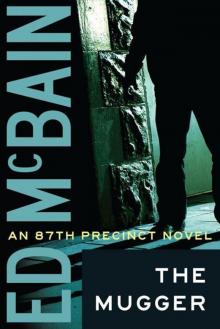 87th Precinct 02 - The Mugger
87th Precinct 02 - The Mugger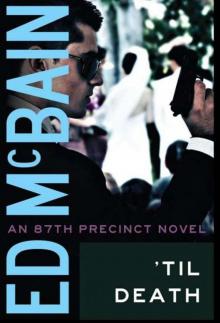 87th Precinct 09 - Til Death
87th Precinct 09 - Til Death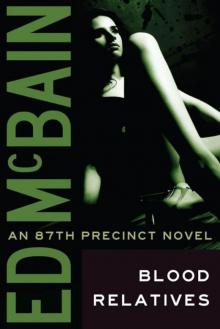 Blood Relatives (87th Precinct)
Blood Relatives (87th Precinct)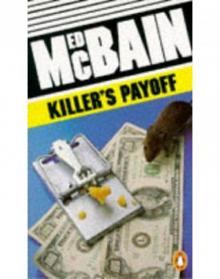 Killer's Payoff
Killer's Payoff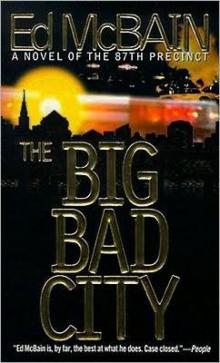 The Big Bad City
The Big Bad City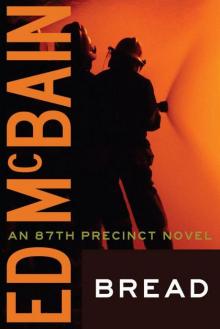 Bread (87th Precinct)
Bread (87th Precinct)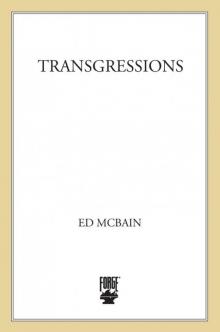 Transgressions Vol. 3
Transgressions Vol. 3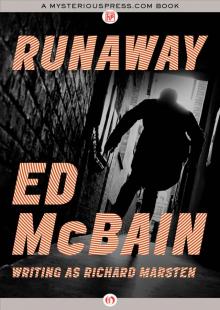 Runaway
Runaway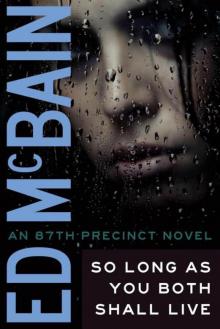 So Long As You Both Shall Live (87th Precinct)
So Long As You Both Shall Live (87th Precinct)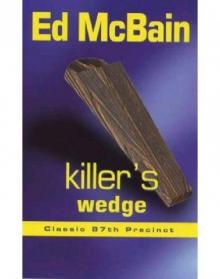 Killer's Wedge
Killer's Wedge